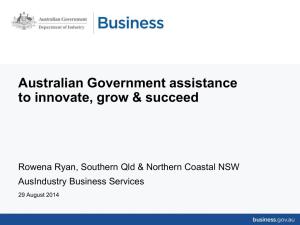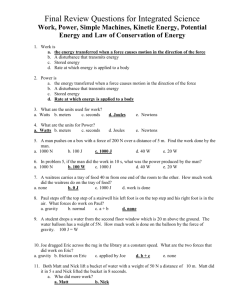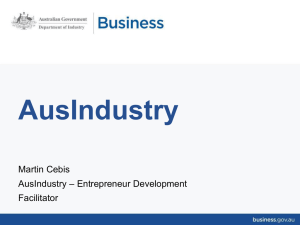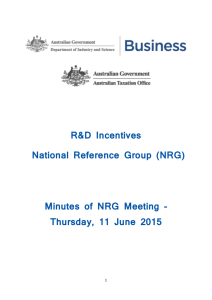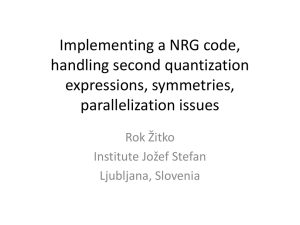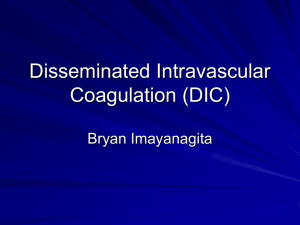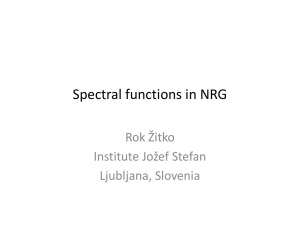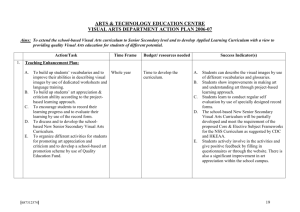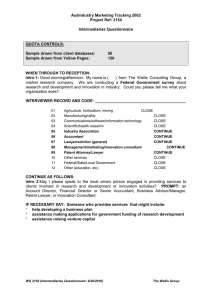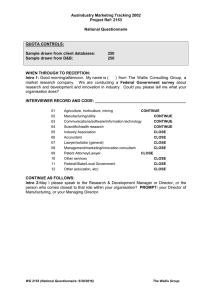Minutes of NRG Meeting - Thursday, 4 December
advertisement
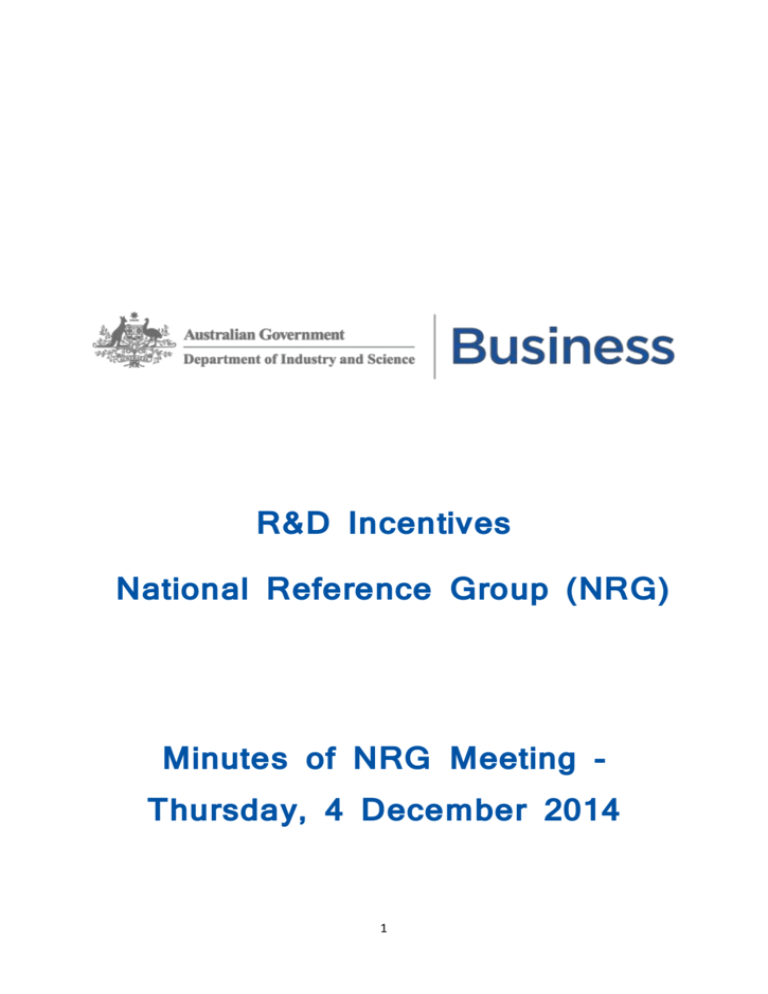
R&D Incentives National Reference Group (NRG) Minutes of NRG Meeting - Thursday, 4 December 2014 1 Attendance & Apologies 1. External Members: Donna Bagnall – Institute of Chartered Accountants Australia Leigh Conlan – CPA Australia Jason Dunnachie – Deloitte (proxy for Serg Duchini) David Gelb – KPMG Paul McMullan – Compliance Group Sandra Mason – Pricewaterhouse Coopers Jamie Munday – Ernst & Young Melanie Reen – Michael Johnson Associates (proxy for Kris Gale) Lisa Springer – Member, Innovation Australia’s R&D Incentives Committee Matt Wenham – ATSE (proxy for Margaret Hartley) Rudi Werner – The Fourth Wave ATO: Malcolm Allen (Co-Chair) Jared Birbeck – Teleconference Terry Hughes - Teleconference AusIndustry: David Wilson (Co-Chair) Chris Enders Darren Evans (Victorian State Office) Andrew Lewis Alison Sare (Victorian State Office) Adrian Wilson Department of Industry: Luke Summers, Acting Manager Business Taxation Policy Apologies: Serg Duchini – (Deloitte) David Fox – (CTA) Kris Gale – (MJA) Margaret Hartley – (ATSE) Minutes and actions arising from previous meeting 2. No issues were raised with the previous meeting minutes which were circulated to NRG members on 17 June 2014 and subsequently posted to the AusIndustry website. David Wilson noted that the R&D Tax Incentive materials had been rebranded as part of the Single Business Service and were now located on the business.gov.au website. Action Item 1 (The ATO will consult with NRG members as an alternative R&D Schedule calculator is scoped) - David Wilson noted that Jared Birbeck will discuss the R&D Schedule calculator with the NRG via telecon in the afternoon. 2 This Item will be kept as an ongoing action item. Action Item 2 (Investigate and clarify any issues related to technical legislative amendments put forward during the meeting) - While details are not yet certain, the government may consider legislative change options as part of the upcoming Taxation White Paper process. - NRG members were encouraged to send any suggestions regarding technical legislative amendments to AusIndustry and the ATO. Action Item 3 (Provide feedback on the Registration Smart Form to AusIndustry) is covered under Agenda Item 4.1. - David Wilson noted that there were no plans this income year for an update to the registration form. However AusIndustry is considering updates to the Advance/Overseas Finding application form in the first half of 2015. - NRG members were encouraged to send any comments or feedback on either form to AusIndustry. Action Item 4 (Consider holding a workshop in 2014 to discuss issues such as AAT decisions in the context of the AusIndustry interpretive guide currently under development) - The Mt Owen AAT decision was delivered at the time AusIndustry was developing the R&D Tax Incentive: A Guide to Interpretation. As a result, the text of the guide was informed by the AAT’s decision. - Following the Mt Owen decision and the release of the Guide to Interpretation there have been detailed communications and discussion of interpretation with consultants through various channels. - The meeting considered that there wasn’t a strong need to hold an NRG workshop to discuss the consequences of the decision. Strategic Matters 3. 3.1 Program Performance David Wilson presented an overview of key program performance data on registrations and Advance/Overseas findings occurring in 2012-13 and 2013-14 (as at 30 September 2014). David Wilson noted that the second full year of registrations for the R&D Tax Incentive (for the 2012-13 income year) had just been completed, which was the first full year of the R&D Tax Incentive without the R&D Tax Concession running at the same time. The number of new claimants to the program had increased on the previous year, as had the number of registrations. The majority of new claimants were small or medium level enterprises. 3 David Gelb asked if statistics were available to show the breakdown of new claimants into large and small enterprise categories, and the number of new claimants and their State location. This could be useful data to inform the Tax White Paper. Chris Enders reported that number of new claimants was approximately 2500 and the number of large claimants within this number was fewer than 20. David Wilson discussed the 2012-13 Science Research and Innovation tables. The tables are a whole of government report and for R&D Tax show the level of forgone government revenue resulting from the offsets. A link to these tables will be circulated to the NRG membership. The membership discussed the proposed $100 million cap on R&D expenditure that was being debated in the Senate. Questions were raised about how many companies might be affected and the level of savings that could be expected if this measure were to become law. David Gelb explained that some companies might get caught out as there had not been much public exposure of this proposal before it was raised as an amendment. David Wilson discussed registration statistics for the States. The number of registrations from Queensland and Western Australia had increased while the registrations for South Australia were down slightly. Following the last of the Tax Concession registrations, these figures can be used as baselines for tracking changes in registration numbers for the R&D Tax Incentive. The membership discussed the issue of the impact of the offsets on the imputation system and asked the question as to whether it could be modelled. The membership heard that the Taxation White Paper was an appropriate opportunity to raise this matter. 3.2 Program Developments David Wilson advised that recent Specific Issue Guidance on the duration of overseas findings will reduce the number of applications for overseas findings. Andrew Lewis explained that a ‘refused’ application for an Advance finding occurs when there is not enough information provided to make an assessment of the activities’ eligibility. A refused application is not detrimental as it is not a negative finding, however it does not provide the certainty of a positive finding. David Gelb noted the number of applications that had been withdrawn and asked if it was known why the number was that high. Andrew Lewis advised that the number largely reflects company drafted applications where the company changed their view about the eligibility of their application and withdrew it before a negative finding was made. Andrew Lewis advised that an average processing time for an Advance/Overseas finding application was around three months though the processing time cannot be guaranteed. Processing time depends on a number of factors including whether the registrant submits the application in, or close after, a peak application time and whether sufficient information had been provided in the application, or whether further information was needed. Applications are mostly assessed by State offices, however a significant number were still being assessed in the National Office. Application quality was improving however applications still generally lacked all the information needed to show how they met the requirements, which resulted in 4 assessors having to make further enquiries. Applications are now beginning to be submitted more evenly across the year with fewer arriving in the final week before the deadline. Paul McMullan noted that later applications are often better written because they have access to better data. Mr McMullan said that the form was restrictive as 4,000 characters was not a lot of space to provide the relevant information. Andrew Lewis noted that the specifics of what made the work being undertaken R&D are often overlooked and application details are too general. He also noted that applicants could attach further information to their applications if they did not have enough space in the form. Paul McMullan advised that the form crashes during drafting and to get around this he needed to draft the application in Word and copy it into the fields. Andrew requested that any feedback on the form be provided to enable the issue to be considered. The pdf form crashing issue will be taken off line and examined. The form will be revised in 2015 and the NRG will be consulted further as this occurs. Sandra Mason stated that the registration timeframes seem to have slowed down and were not meeting the standard set out in the Charter. Chris Enders advised the members that registration applications are received in peaks, particularly in April where approximately 40% of applications arrived (~1,500 of which arrive on the last day). AusIndustry has also experienced some outside influences that had impacted on processing times (including moving buildings, system closedowns and staff movements). AusIndustry will look to see if there is anything further it can do to accelerate the processing of registrations. The NRG noted that members have received some registration letters that were dated two weeks earlier. Chris Enders advised that the delay in receipt of these letters was due to incorrect registrant email addresses on the application. 3.3 Program Communications David Wilson advised that the refresh of the website has been widely welcomed by users. The refresh was aligned with the launch of the R&D Tax Incentive Snapshot which was aimed at companies that were new to the program. Stakeholder Engagement 4. Stakeholder Engagement Strategy The Program has developed a refreshed formal Stakeholder Engagement Strategy, which identifies key stakeholder groups and considers their interests and how best to engage with them. David Wilson told the members that the Stakeholder Engagement Strategy will be progressively implemented over 2015. Model for engaging with specialist tax agents The Model for engaging with specialist tax agents paper presented by Chris Enders proposed to establish connections between the NRG and the State-based stakeholder meetings. The paper proposed that the number of NRG meetings be two per year with NRG/State meetings occurring between those meetings in the odd quarters. This would allow matters to be referred from NRG meetings to the State-based meetings and vice-versa. It is envisioned that National Reference Group meetings would 5 operate at a higher level while the State-based meetings would discuss more technical matters. Rudi Werner asked if the proposal would allow the NRG to have a more strategic role. David Wilson advised that the Charter brings all activities together, however this could be looked at further. Mr Werner suggested that the proposal would assist with forming and maintaining stakeholder connections with AusIndustry, and provide a picture of any State-based differences to enable reporting back to NRG. Leigh Conlan enquired into who were the interested bodies that did not have NRG representation. David Wilson advised that tier 2 and 3 advisors did not have representation. Chris Enders elaborated that members of the NRG had a national presence which facilitated the forming of links between the State-based meetings. Alison Sare advised the members that the States used three levels of engagement with specialist tax advisors; top 5, top 5-10 and those below 10. Eighty percent of those being engaged were CPAs or members of the Tax Institute. Leigh Conlan advised that he had not heard any feedback from local members. David Gelb stated that attending the State meetings would assist to build relationships and hear the detail from the State level. Jason Dunnachie enquired if there would be common attendees from AusIndustry and Chris Enders stated that one or other of the Managers from the National Office R&D Tax Team would aim to be in attendance at the State meetings but may not be able to be there for every meeting. R&DIC Member 5. Dr Lisa Springer provided the members with a brief account of her professional background which included roles in financial services, life sciences, health, ICT, clean technology and pharmaceuticals. Dr Lisa Springer advised the membership that while there are a number of program delegates who may make decisions, R&DIC decides the higher risk matters, such as matters flagged by the ATO, or those that were more complex in nature. The role of a R&DIC member included regular meetings, preparation for meetings, proactive submissions on matters of relevance to the program, and review and consultative roles. To arrive at decisions, R&DIC received information about activities which was more detailed than the information provided in the application. Prior to the matter being decided by R&DIC, AusIndustry staff considered the information in the application and sought additional information to clarify any aspects that were not clear or absent from the application. R&DIC also had access to any independent expert reports that had been prepared. Dr Springer told the members that R&DIC challenges AusIndustry on its assessments and does not automatically accept reports it receives. Lisa Springer told the members that R&DIC noted two issues with applications: 1. Applications do not contain the level and detail of information that is needed to assess the claims which means that supporting documents are required. This often occurs with small companies. 2. Larger companies often lodge applications with many activities grouped together (such as whole of project applications) with an expectation that all activities and expenditure associated with the project are claimable. This type of application requires AusIndustry to carefully segment the activities in order to be able to identify any elements of eligibility. 6 Dr Springer told the members that the R&D Tax Incentive was important for driving innovation in Australia. Consequently, it was very important that companies put in submissions to the Taxation White Paper to communicate their views and experiences. David Gelb asked Dr Springer how R&DIC managed the decision process when the risks between R&DIC and ATO were of a different nature. Dr Springer advised that when the regulators made decisions they focused on their own domain. For example, a claim might meet the requirements within the Innovation Australia/AusIndustry domain but not that of the ATO. R&DIC’s purview is to examine issues within Innovation Australia/AusIndustry space only. Malcolm Allen elaborated that the ATO was not a member of R&DIC but had observer status so it could understand the reasoning being used in decisions. The two regulators work together to get clear risk profiles. Sandra Mason told the members that she heard Dr Springer’s message about documentation and enquired what it was that convinced R&DIC that the outcome of an activity was new knowledge. Lisa Springer responded that it was information outside the company; external validation is useful even if it is a statement of the knowledge gap. Melanie Reen asked if the character limits in the forms could cause applications to be selected for reviews. Chris Enders advised that this was not the case, as additional information could be attached to an application if applicants needed more space. Leigh Conlan asked if companies had requested R&DIC to make the assessment of their application rather than AusIndustry. Chris Enders advised that there was no provision under the legislation for such a request. AusIndustry provides resources to support R&DIC. Lisa Springer told the members that the decision made by R&DIC was based on the information in the assessment report prepared by AusIndustry and that a lot of work had gone into analysing the application and asking follow up questions before R&DIC saw the matter. Paul McMullan asked if decisive information was provided to R&DIC following its own enquiries why had it not been provided to AusIndustry. Lisa Springer advised that the company may not have adequate records; Paul McMullan noted that the company may have needed to create the relevant document. Leigh Conlan advised that asking for the hypothesis makes it more clear as to what information, and the level of detail, is needed from the applicant. 7 Operational Matters 6. 6.1 NRG Member Items Mismatch of expenditure in relation to document vs tax return Rudi Werner raised a question about the appropriate way to manage a situation where a contractor engaged by a company issued an invoice prior to 30 June for claimable expenditure and the invoice was paid after 30 June and reversed in the books. Mr Werner raised this issue as the registration form did not provide the ability to record negative entries. The issue was discussed by members who advised that an amending tax claim needed to be made for the year in which the invoice was issued. The meeting noted that: 1. ATO and AusIndustry understand that for reasons including that the forms are completed at different times, amounts declared on the AusIndustry registration application may not be identical to the amounts claimed on the corresponding tax return. 2. Costs associated with activities should be included in the AusIndustry registration application in the year in which the activities occur (even if it means that one must make an estimate of those costs) and the costs should be claimed in the relevant tax return; where relevant is dependent on the accounting methods used by the claimant and tempered by the rules relating to payments to associates. The meeting raised the question as to whether the form might be updated to provide warning messages where entry errors had occurred. Chris Enders advised the meeting that the registration team contacts companies when they identify entry errors in registration applications. AusIndustry will examine the form in the next iteration to see if automated error checking can be programmed in. 6.2 Administrative Update Draft Feedstock Specific Issue Guidance Jared Birbeck talked to the members about the draft feedstock guidance paper, particularly noting that the paper was jointly drafted by ATO and AusIndustry. The paper provides an administrative solution to companies which do not wish to report feedstock adjustments. The solution involves companies not registering the parts of activities that give rise to a feedstock adjustment (the feedstock inputs). Melanie Reen raised a question as to whether the guidance produced a new concept (‘parts of aggregated activities’) that had not been appropriately defined. Andrew Lewis noted that the claimant defined the activities at registration and had a degree of discretion in how this was done. Jared Birbeck added that sufficient detail was used in the guidance to make the meanings clear. Melanie Reen raised an additional question as to whether companies that were changing the nature of their business could still make this choice. Mr Birbeck noted that it while it may depend on the specifics, it would appear that the company was still carrying on a business. David Gelb enquired as to when applicants and advisors can act on the guidance and was advised that the position outlined in the guidance was settled (agreed by both 8 ATO and AusIndustry) and that AusIndustry would endeavour to publish the final document before Christmas. The effect of section 355-715 of the Income Tax Assessment Act 1997 was discussed with members enquiring whether expenditure could be claimed under s8-1 if the relevant activity the expenditure related to had already been registered under the R&D Tax Incentive but not claimed. Jared Birbeck advised that where an R&D activity had been registered it was not possible to claim an 8-1 deduction for expenditure on that activity. However, it is up to the entity to identify whether there clearly was (or wasn’t) a nexus between the expenditure and the activity. Where it could be shown the expenditure was not on the R&D activity an 8-1 deduction could be available. Following the discussion on the draft Feedstock guidance paper, Jared Birbeck advised the members that the R&D Calculator smart pdf was released on the ATO website in July. The basic calculations performed by the tool included feedstock and includes an over write facility. The tool automatically calculates percentage of offset that is relevant to the details entered but does not perform calculations for clawback. Malcolm Allen added that the redesign of the website involved changing the underlying software which resulted in follow on challenges for the calculator. 6.3 Roundtable Feedback No comments were made during the roundtable feedback. Other Business & Closing Remarks 7. Malcom Allen advised the members: The ATO has become aware of behaviour within the Research and Development industry that is causing serious concern. It has become apparent that there are consultants marketing R&D arrangements to clients that may have the character of tax avoidance arrangements. The ATO is concerned that these consultants may be promoting tax avoidance arrangements and as a consequence may attract the application of the Promoter Penalty Laws. The main objective of these laws is to deter the promotion of tax avoidance and evasion schemes. The ATO is also concerned about a trend we have noted that some Tax agents and accountants, in the preparation of annual tax returns, appear to accept Incentive claims prepared by R&D consultants without conducting due diligence on those claims. The ATO is working closely with AusIndustry to identify and address these behaviours. With all agenda items concluded the meeting was closed at 2.25pm 9 Action Item 1 2 3 4 5 Description Delivery Date The ATO will consult with NRG members as an alternative R&D Schedule calculator is scoped A link to the 2012-13 Science Research and Innovation tables will be circulated to the NRG membership Publish the Specific Issue Guidance topic on Feedstock Provide feedback on the Registration smart form to AusIndustry Provide feedback on the Advance/Overseas Finding smart form to AusIndustry 10 Responsibility Ongoing ATO 29 Jan 2015 AusIndustry 3 Feb 2015 AusIndustry Ongoing NRG Members Ongoing NRG Members
